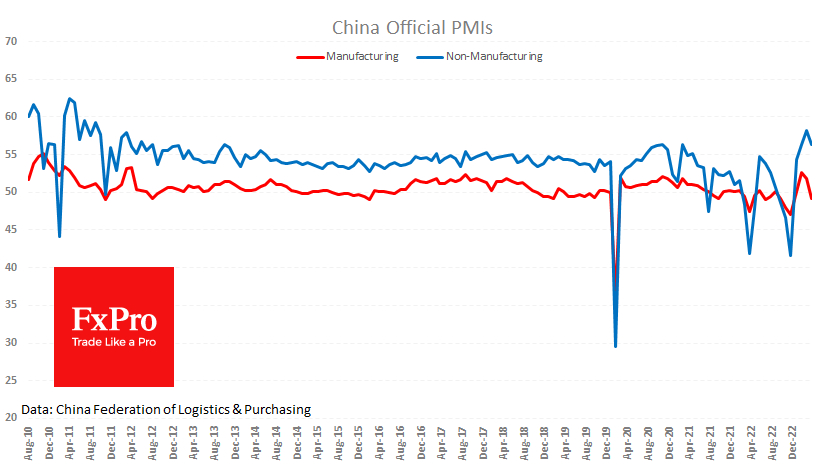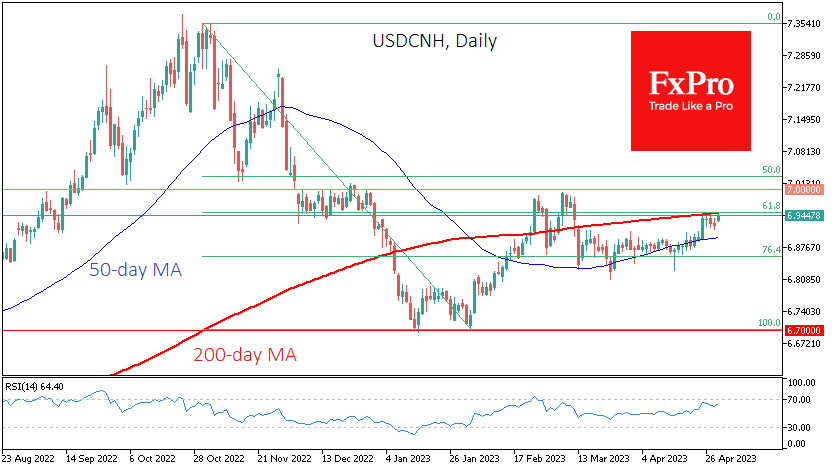China's PMIs released over the weekend were much weaker than expected, with the manufacturing index signalling a downturn.
The official manufacturing PMI fell to 49.2 in April from 51.9 the previous month and 51.4 expected. This sudden drop suggests that the economy had lost momentum much more quickly than analysts had expected, following a brief boom at the end of last year after the end of the 0-covid policy. The publication's commentary suggests a contraction in manufacturing demand after several months of rapid growth.
Historically, last month's levels are nothing to write home about. Chinese manufacturing activity is close to stagnation or even contraction, with a downtrend in the PMI from 2018 despite a very bumpy road due to COVID-19.
The non-manufacturing sector feels much better, losing 1.8 percentage points over the month to 56.4. The long history clearly shows that the growth rate of the non-manufacturing sector has long been a drag on the economy.
Traditionally, market participants pay more attention to production dynamics as it sheds light on global trends and allows for assessing export and import potential, affecting the renminbi exchange rate. Moreover, production often acts as a leading indicator of economic trends.
In this context, it is unsurprising that the renminbi fell, and the USDCNH rose on Monday. Last week it broke above its 200-day MA at 6.95 but did not dare to break through. At the same time, the pullback level to 61.8% of the November and February declines is also in this area.
A decisive break of this long-term trend indicator is likely to be postponed by the outcome of the Fed meeting. A move lower in the USDCNH could be the prologue to a move lower to 6.30 in the coming months. A sharp move higher would reclassify the pair's rise in recent weeks from a correction to a new advance and could lead to a significant increase in the pair's volatility.
The FxPro Analyst Team
- English (UK)
- English (India)
- English (Canada)
- English (Australia)
- English (South Africa)
- English (Philippines)
- English (Nigeria)
- Deutsch
- Español (España)
- Español (México)
- Français
- Italiano
- Nederlands
- Português (Portugal)
- Polski
- Português (Brasil)
- Русский
- Türkçe
- العربية
- Ελληνικά
- Svenska
- Suomi
- עברית
- 日本語
- 한국어
- 简体中文
- 繁體中文
- Bahasa Indonesia
- Bahasa Melayu
- ไทย
- Tiếng Việt
- हिंदी
Chinese Manufacturing PMI Cools More Than Expected
Published 05/01/2023, 08:09 AM
Chinese Manufacturing PMI Cools More Than Expected
Latest comments
Loading next article…
Install Our App
Risk Disclosure: Trading in financial instruments and/or cryptocurrencies involves high risks including the risk of losing some, or all, of your investment amount, and may not be suitable for all investors. Prices of cryptocurrencies are extremely volatile and may be affected by external factors such as financial, regulatory or political events. Trading on margin increases the financial risks.
Before deciding to trade in financial instrument or cryptocurrencies you should be fully informed of the risks and costs associated with trading the financial markets, carefully consider your investment objectives, level of experience, and risk appetite, and seek professional advice where needed.
Fusion Media would like to remind you that the data contained in this website is not necessarily real-time nor accurate. The data and prices on the website are not necessarily provided by any market or exchange, but may be provided by market makers, and so prices may not be accurate and may differ from the actual price at any given market, meaning prices are indicative and not appropriate for trading purposes. Fusion Media and any provider of the data contained in this website will not accept liability for any loss or damage as a result of your trading, or your reliance on the information contained within this website.
It is prohibited to use, store, reproduce, display, modify, transmit or distribute the data contained in this website without the explicit prior written permission of Fusion Media and/or the data provider. All intellectual property rights are reserved by the providers and/or the exchange providing the data contained in this website.
Fusion Media may be compensated by the advertisers that appear on the website, based on your interaction with the advertisements or advertisers.
Before deciding to trade in financial instrument or cryptocurrencies you should be fully informed of the risks and costs associated with trading the financial markets, carefully consider your investment objectives, level of experience, and risk appetite, and seek professional advice where needed.
Fusion Media would like to remind you that the data contained in this website is not necessarily real-time nor accurate. The data and prices on the website are not necessarily provided by any market or exchange, but may be provided by market makers, and so prices may not be accurate and may differ from the actual price at any given market, meaning prices are indicative and not appropriate for trading purposes. Fusion Media and any provider of the data contained in this website will not accept liability for any loss or damage as a result of your trading, or your reliance on the information contained within this website.
It is prohibited to use, store, reproduce, display, modify, transmit or distribute the data contained in this website without the explicit prior written permission of Fusion Media and/or the data provider. All intellectual property rights are reserved by the providers and/or the exchange providing the data contained in this website.
Fusion Media may be compensated by the advertisers that appear on the website, based on your interaction with the advertisements or advertisers.
© 2007-2025 - Fusion Media Limited. All Rights Reserved.
